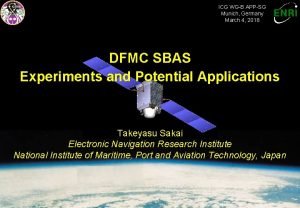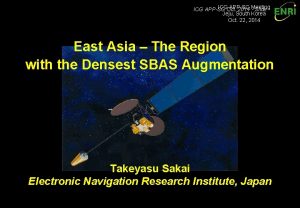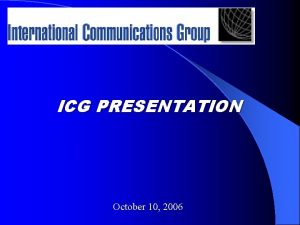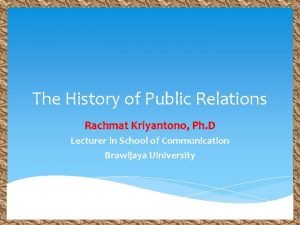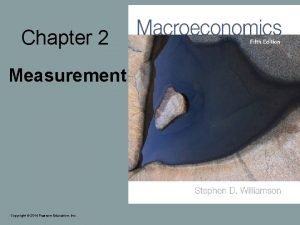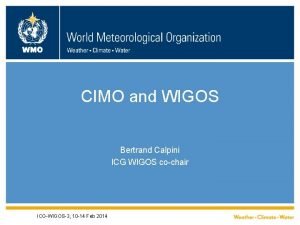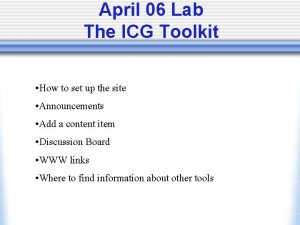ICGOct APPSG ICG APPSG 2014 Meeting Slide Jeju


















- Slides: 18

ICGOct. APP-SG ICG APP-SG 2014 Meeting - Slide Jeju, South Korea Oct. 22, 2014 East Asia – The Region with the Densest SBAS Augmentation Takeyasu Sakai Electronic Navigation Research Institute, Japan

ICG APP-SG Oct. 2014 - Slide 1 Introduction • We are going to have more SBAS services: – Japan and India are operating MSAS and GAGAN, respectively. – Russian SDCM, Chinese SNAS (COMPASS-SBAS), and Korean K-SBAS are planned and being developed; SDCM is already broadcasting test signal. – We will have 5 SBAS in East Asia Region soon; Their service areas are overlapping. • Basically good news, but maybe some issues: – – Increased opportunity of SBAS signal; But degraded C/N 0 due to interference. Users can choose the best SBAS; But how should users choose the best? Need to equip many channels in user receivers. Interoperability and legal issues might also arise. • Coordination and communications: – Interoperability between SBAS services is important from user’s perspective. – Users should be informed the situation and should make feedbacks.

ICG APP-SG Oct. 2014 - Slide 2 MSAS Service by Japan • Japanese MSAS (MTSAT Satellite Based Augmentation System) has been operational since 2007 with two GEO satellites at 140 E and 145 E. • The global beam of MTSAT GEO widely covers the East Asia Region. • Basically serves for users within Japanese FIR; Used for Enroute flights and horizontal navigation on the ground.

ICG APP-SG Oct. 2014 - Slide 3 Architecture of MSAS MTSAT-1 R GPS Satellites Ranging Signals Users Augmentation Signals Kobe MCS (and GMS) Sapporo GMS Fukuoka GMS Ground Network Naha GMS • • • MTSAT-2 Tokyo GMS Hitachi-Ota MCS (and GMS) Hawaii MRS Australia MRS 6 GMS in Japan Hawaii MRS Canberra MRS MSAS Monitor Stations 2 GEO, 2 MCS (Master Control Station), 4 GMS (Ground Monitor Station), and 2 MRS; MCS also has GMS function; MSAS has 6 domestic monitor stations. 2 MRS (Monitor and Ranging Station) for GEO positioning for GEO ranging function.

ICG APP-SG Oct. 2014 - Slide 4 Performance of MSAS GPS only w/ MSAS Horizontal 0. 425 m RMS GPS only w/ MSAS Vertical 0. 607 m RMS N-S U-D E-W GEONET 940058 (Takayama) 08/1/17 -19 PRN 129 (MTSAT-1 R) Broadcast Signal

ICG APP-SG Oct. 2014 - Slide 5 SBAS in the World (1) • US WAAS (Wide Area Augmentation System): – The first SBAS operational since July 10, 2003. – Currently serving Enroute to LPV-200 flight modes with 3 GEO, after stepwise performance improvements. – Now Phase-IV: Developing dual frequency operation system. • Japanese MSAS (MTSAT Satellite Based Augmentation System): – Operational since Sept. 27, 2007 with 2 GEO. – Currently serving Enroute to NPA (Non-Precision Approach) flight modes; Available only for horizontal navigation. • European EGNOS (European Geostationary Navigation Overlay Service): – Operational since March 2011 after broadcasting test signal in 2005. – Currently EGNOS v 2 serving Enroute to LPV flight modes with 2 GEO. – Ongoing performance improvement for LPV-200 operation. – EGNOS v 3 is planned for dual frequency operation with Galileo.

ICG APP-SG Oct. 2014 - Slide 6 SBAS in the World (2) • Indian GAGAN (GPS-Aided Geo-Augmented Navigation): – Operational since Feb. 14, 2014 with 2 GEO. – Currently serving Enroute to NPA; Certification for LPV operation is ongoing. • Russian SDCM (System for Differential Corrections and Monitoring): – Already broadcasting test signal from their geostationary satellites. – Consists of 3 geostationary satellites: 2 already on orbit and 1 more in 2014. – In Japan, signals from Luch-5 A and Luch-5 V are possibly received • We have already received PRN 140 signal from Luch-5 A. • Chinese SNAS (COMPASS-SBAS): – Served as a part of Bei. Dou/COMPASS Satellite Navigation System. – Consists at least 3 Geostationary satellites at 80 E, 110 E, and 140 E; All signals can be received in Japan. • Korean K-SBAS: – Planned with 1 or 2 GEO to be operational by around 2020.

ICG APP-SG Oct. 2014 - Slide 7 SBAS in the World (3) SDCM SNAS K-SBAS Operational Since 2003 Since 2011 Since 2014 Since 2007 SACCSA • • • Already Operational: WAAS, MSAS, EGNOS, and GAGAN. Planned and Being Developed: SDCM, SNAS, K-SBAS, and SACCSA, … We will have 5 SBAS in East Asia Region: The Densest Region in the World !

ICG APP-SG Oct. 2014 - Slide 8 Good News? • We will have 5 SBAS in East Asia Region soon: – Operational: Japanese MSAS and Indian GAGAN. – Upcoming: Russian SDCM, Chinese SNAS, and Korean K-SBAS by 2020. – Other systems? • Possible advantages: – Increased opportunity of SBAS augmentation signal. • Expect 10 or more GEO satellites broadcasting SBAS signals. • Possibility to receive some of SBAS signals which survives in urban canyon. – Users can choose the best SBAS available. • Criteria: Highest elevation angle, lowest HPL, the largest number of SV, … – Also mixed use of multiple SBAS is possible. • Increased number of GPS satellites with augmentation. • Russian SDCM would augment GLONASS as well as GPS. – Increased ranging signals from SBAS GEO. • Some SBAS provide ranging function: currently only MSAS.

ICG APP-SG Oct. 2014 - Slide 9 Potential Issues • Lower C/N 0 due to other SBAS signals: – SBAS signals interfere each other. – ITU frequency coordination might limit the bandwidth of some SBAS signals. • Induces degradation of ranging accuracy. • How should user choose the best SBAS? – Criteria: Highest elevation angle, lowest HPL, the largest number of SV, … – Need to be standardized? • If not, we cannot predict the actual performance of user receivers. • User receivers need to equip many channels to track SBAS satellites: – Need additional channels to choose the best SBAS and for transition of augmentation source. – Also need to decode and process SBAS signals being tracked: Increased computational loads. • Interoperability between SBAS. • Legal issues between States: – Problems to use SBAS provided by another State. – Could an SBAS provider assure to continue its service for other States?

ICG APP-SG Oct. 2014 - Slide 10 Example: MSAS and GAGAN Geostationary Satellites: MSAS GSAT-8 GSAT-10 MTSAT-1 R @140 E MTSAT-2 @145 E MTSAT-2 GAGAN GSAT-8 @55 E GSAT-10 @83 E • India began the operation of GAGAN in Feb. 2014. • In Japan, we can receive GAGAN signals in addition to MSAS signals. • Which SBAS does the SBAS-receiver use for augmentation? Ø Likely MSAS, but using GAGAN is allowed and possible. Ø There is some reports on observation of some receivers using GAGAN.

ICG APP-SG Oct. 2014 - Slide 11 Interference between SBAS Estimated C/N 0 with Interference Degradation of C/N 0 • Degradation of C/N 0 of MSAS signals due to interference from other SBAS. • Assume 12 GEO: 2 GAGAN GEO, 3 SDCM GEO, 5 COMPASS GEO, and 2 K -SBAS (120 E and 130 E); All broadcast SBAS L 1 C/A signals. • Max degradation: 0. 46 d. B/Hz at 116 E.

ICG APP-SG Oct. 2014 - Slide 12 SBAS Satellite Selection (1) MSAS Availability (1 Critical GPS Out) • • • GAGAN Availability (1 Critical GPS Out) Example case: Availability of navigation using either MSAS or GAGAN. NPA mode (RNP 0. 3 for Enroute) availability for 3 days of May 25 to 27, 2014. The service area is limited to each region.

ICG APP-SG Oct. 2014 - Slide 13 SBAS Satellite Selection (2) Selection by Elevation Angle (1 Critical GPS Out) Selection by HPL (1 Critical GPS Out) • Availability of navigation for receivers which select MSAS or GAGAN as an augmentation source. • Selection criteria: (Left) Higher elevation angle; or (Right) Lower HPL. • Selecting SBAS extends the service area as expected.

ICG APP-SG Oct. 2014 - Slide 14 Interoperability • Interoperability between SBAS: – Important from user’s perspective. – Property that user receivers can receive and process any SBAS signals broadcast by different service providers in the completely same manner. – Information broadcast on different SBAS signals has the same property. • Same definition of the contents. • Must be certified for the same level of integrity. • Interoperability is not assured automatically: – SBAS is the international standard system defined by the ICAO SARPS. • However, there are some ambiguities: MT 9 for non-ranging GEO (recently clarified), LTC for broadcasting/non-broadcasting GEO, GPS/GLONASS offset, … • Also there are some options: MT 27 or MT 28, usage of MT 6, … – Need communications between SBAS providers: • ICAO meetings twice a year. • SBAS IWG (Interoperability Working Group) Meeting twice a year. – Feedback from users is welcome.

ICG APP-SG Oct. 2014 - Slide 15 Legal Issue: Monitoring SBAS • Monitoring SBAS: – Another issue might be the necessity of monitoring the performance of the system operated by other States. – SBAS is used as a primary means of navigation. • Question: Is it allowable to fly in the airspace of a State dependently upon a primary means of navigation provided by another State? – A possible way to relax such legal issues caused by using SBAS operated by another State is to monitor the performance of the SBAS. • If necessary, warn to users in the airspace in case that the SBAS should not be used. • Actually, in Spring 2014, MSAS has broadcast messages with anomalous preambles. • GNSS Monitor System: – In order to monitor an SBAS, one also needs to monitor GPS satellites augmented by the SBAS to check correctness of augmentation information. – Japan Civil Aviation Bureau intends to implement monitor systems for GNSS including GPS and SBAS whose signal can be received in Japanese territory.

ICG APP-SG Oct. 2014 - Slide 16 GAGAN Integrity in Tokyo All-in-View Mode All Possible Combinations • Triangle chart comparing HPL and the associated position error provided by GAGAN GSAT-10 in Tokyo, Japan. • The availability of NPA mode is 97. 8% for all-in-view receivers. • In terms of safety assurance, all possible combinations should be tested like the chart at the right; Unsafe condition that the error exceeds HPL did not occur for this period. • Furthermore, all possible combinations of active SBAS messages should be tested.

ICG APP-SG Oct. 2014 - Slide 17 Conclusion • Situation in East Asia Region: – We will have 5 SBAS in East Asia Region soon: MSAS, GAGAN, SDCM, SNAS (COMPASS-SBAS), and K-SBAS. – Their service areas are overlapping each other. • Basically good news, but maybe some issues: – Need analysis and consideration in detail from user’s viewpoints. • Coordination and communications: – Interoperability between SBAS services is important from user’s perspective. – Users should be informed the situation and should make feedbacks.
 Cafeteria
Cafeteria Korea international school jeju
Korea international school jeju Appsg
Appsg Appsg
Appsg Heel toe polka music
Heel toe polka music Aerorouter
Aerorouter Illinois mental health collaborative
Illinois mental health collaborative Icg portsmouth
Icg portsmouth Itc-icg 09
Itc-icg 09 D'annunzio tesina terza media
D'annunzio tesina terza media What is meeting and types of meeting
What is meeting and types of meeting What is meeting and types of meeting
What is meeting and types of meeting Today meeting or today's meeting
Today meeting or today's meeting Today meeting or today's meeting
Today meeting or today's meeting Factoring slide and divide method
Factoring slide and divide method Kriyantono 2014
Kriyantono 2014 2014 pearson education inc
2014 pearson education inc Teacher twins 2014
Teacher twins 2014 Sys.sp_cdc_change_job
Sys.sp_cdc_change_job


